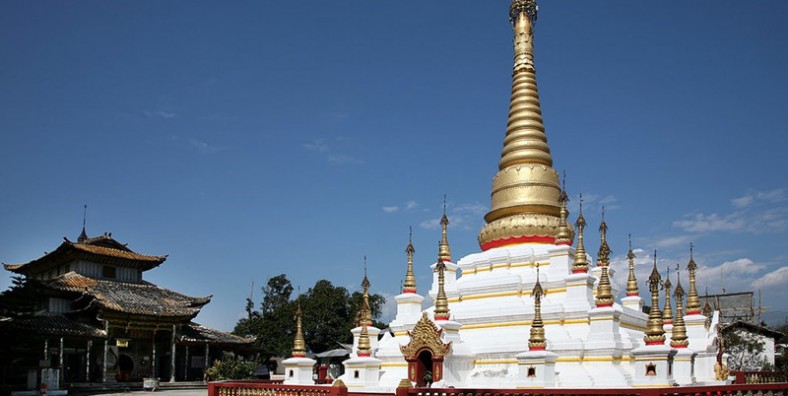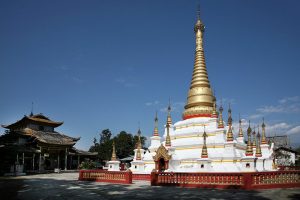 alt="Puer Surrounding Counties and Towns: Weekly & Special Local Markets Travel Guide"
/>
alt="Puer Surrounding Counties and Towns: Weekly & Special Local Markets Travel Guide"
/>
Fengping Buddhist Pagoda in Mangshi City, Dehong

Attractions Overview
Fengping Buddhist Pagoda is one of the scenic spots in Dehong Prefecture. It is tall and majestic with exqusite and magnificent style, novel building design. It is characterized by the unique ethnic feature, which is a treasure in the Dai people’s architecture of Hinayana. The reconstructed Fengping Buddhist Pagoda, with 225m2 of the pagoda footing and 23-meter main pagoda is surrounded by 28 small pagodas, as if all the stars bend towards the moon to protect the main pagoda, which forms the tall and magnificent main pagoda.
Chinese Name: 芒市风平佛塔(Pinyin: Mangshi Fengping Fota)
English Name: Fengping Buddhist Pagoda in Mangshi City, Dehong
Attraction Type: Pagoda
Seasons: All year round
Recommended Visiting Time: Under 1 hour
Opening Hours: 9:00-17:00
Admission Fee: Free
Address: 9 kilometers west of Mangshi, the right side of the road from Mangshi to Ruili(芒市西9公里处,从芒市到瑞丽的公路右侧)
Why is Fengping Buddhist Pagoda So Special
Fengping Buddhist Pagoda is one of the scenic spots in Dehong Prefecture. It is tall and majestic with exqusite and magnificent style, novel building design. It is characterized by the unique ethnic feature, which is a treasure in the Dai people’s architecture of Hinayana. The reconstructed Fengping Buddhist Pagoda, with 225m2 of the pagoda footing and 23-meter main pagoda is surrounded by 28 small pagodas, as if all the stars bend towards the moon to protect the main pagoda, which forms the tall and magnificent main pagoda. Its shape is complex, rigorous and magnificent its shape Complex, rigorous and magnificent. The main pagoda and the sub-pagoda have a delicate golden umbrella at the tip of the pagoda. The umbrella has a silver bell, which sways in the wind, creaking and pleasant.
When the sun sets, the sunset glows like fire, the scene is more spectacular, and the glittering golden pagoda, with the sun shining, is eye-catching.
Where is Fengping Buddhist Pagoda
It is located in 9 kilometers west of Mangshi, the right side of the road from Mangshi to Ruili.
How to Get to Fengping Buddhist Pagoda
When you arriving in Mangshi, you can charter a car or take a taxi, which takes about 20 minutes.
History of Fengping Buddhist Pagoda
The pagoda has a long history. According to historical records, the earliest Fengping Buddhist Pagoda has two pagodas, the East Pagoda and the West Pagoda. In the 6th year of Qing Emperor Yongzheng (1728), the Mangshi Tusi Fang Ren accepted the initiative of several local Buddhists to build a large Buddhist temple in the center of Mangshiba, for the worshipers of all sects to worship Buddha. The Buddhist temple was built and the Buddha statue was molded. The Tusi personally presided over the Great Buddha’s opening ceremony. In the 25th year of Emperor Qianlong (1760), the Tusi was placed as a pagoda (known as the West Pagoda) on the west side of the Buddhist temple and repaired the Buddhist temple. In the late Qing Dynasty, the mother of Tusi Fang Keming hosted a pagoda on the east side of the Buddhist temple (the Jinbao Pagoda, also known as the East Pagoda). After several wars, the temple pagoda was destroyed, but it was repaired in time and was destroyed in 1966. In 1986, the current Buddhist Pagoda was rebuilt.

Best Time to Go
It is suitable to visit Fengping Buddhist Pagoda all year around. Every season has its own beauty. Of course, you can experience the piety of those Buddhists.
Nearby Attractions
Menghuan Silver Pagoda
The Menghuan Silver Pagoda, known as the Menghuan Qianfo Silver Pagoda, is located on the hilltop opposite the Grand Silver Pagoda and a contemporary new-built Pagoda.The Pagoda is an important building of the Dehong Branch of Yunnan Buddhist College.
Menghuan Golden Pagoda
Menghuan Grand Golden Pagoda is located at Leiyarang Mountain in the southeast of Luxi (Mangshi), the capital city of Dehong Prefecture. It’s the best place to bird-eye view the town of Mangshi and those picturesque Dai villages around. Being 73 meters high, the pagoda is a three-storied octagonal but hollow one. The ground floor is the most impressive. With an area of 2,000 square meters, it’s spacious enough for nearly 2,000 pilgrims to pray at the same time. Enshrined in the hall are mainly Buddhist figures such as Sakyamuni in the east, Guanyin (Goddess of Mercy) in the south, Medicine Buddha in the west, and Maitreya (the Future Buddha) in the north, etc. all of which are made from Myanmar white marble to present grandeur and magnificence.
Mengba Naxi Rare Park
Mengba Naxi Rare Park is at the national AAAA state-level. “Mengba Naxi” in Dai language means “a magical, beautiful and fertile place,” which is just the legendary “heaven.” Situated in Xianchi Road in Mangshi City, the park covers an area of 618 mu, and was built in 2001. It is an ecological park that boasts rare ancient trees, plants and rocks. There are poems to praise it saying that “Ancient trees and rare flowers are planted in the park. There is no parallel with such beautiful scenery, and for such beauty, there is no need to visit a fairyland.” Another poem says that “the universe is full of myths. Stones in the park show its understanding of the nature, and the extraordinary workmanship of nature creates miracles.”

 7 Days GolfingTour
7 Days GolfingTour
 8 Days Group Tour
8 Days Group Tour
 8 Days Yunnan Tour
8 Days Yunnan Tour
 7 Days Shangri La Hiking
7 Days Shangri La Hiking
 11 Days Yunnan Tour
11 Days Yunnan Tour
 6 Days Yuanyang Terraces
6 Days Yuanyang Terraces
 11 Days Yunnan Tour
11 Days Yunnan Tour
 8 Days South Yunnan
8 Days South Yunnan
 7 Days Tea Tour
7 Days Tea Tour
 8 Days Muslim Tour
8 Days Muslim Tour
 12 Days Self-Driving
12 Days Self-Driving
 4 Days Haba Climbing
4 Days Haba Climbing
 Tiger Leaping Gorge
Tiger Leaping Gorge
 Stone Forest
Stone Forest
 Yunnan-Tibet
Yunnan-Tibet
 Hani Rice Terraces
Hani Rice Terraces
 Kunming
Kunming
 Lijiang
Lijiang
 Shangri-la
Shangri-la
 Dali
Dali
 XishuangBanna
XishuangBanna
 Honghe
Honghe
 Kunming
Kunming
 Lijiang
Lijiang
 Shangri-la
Shangri-la
 Yuanyang Rice Terraces
Yuanyang Rice Terraces
 Nujiang
Nujiang
 XishuangBanna
XishuangBanna
 Spring City Golf
Spring City Golf
 Snow Mountain Golf
Snow Mountain Golf
 Stone Mountain Golf
Stone Mountain Golf













 What Our Customers Say?
What Our Customers Say?
